|
This is the fifth and final segment of our travels around Oz, we spend 7 months to get from Melbourne to Melboune...the
long way round, before turning tail and heading back to settle in Brisbane again.
Index
After departing Melbourne we headed off in a North Westerly direction through Ballarat and on to the
Grampians National Park. It has long been on my radar and now we were in the vicinity we made the most of the opportunity. We approached
along the Glenelg Highway, a road I like not only because it’s a Palindrome (spelt the same backwards as it is forwards), but also
because of the magnificent vistas it affords as you approach Dunkeld. The jagged peaks of the Grampians dramatically punctuate the surrounding
perfectly flat landscape like the spine of an extinct Dinosaur erupting through the genteel pastures.

We could, however, have timed it better. Winter has now arrived and the weather has become decidedly nippy.
After two nights of chilly free camping we decided to avail ourselves of a powered site at Takaru Bush Resort (a fancy name for a caravan park)
where we could leave the heater running all night; sheer luxury, and wake to a balmy 16 deg Celsius! We really have little to complain about,
I recall this time last year, we were in England and it was just as cold, even though it was summer over there.

Our first full day in the Grampians started when the early morning fog lifted to reveal a stunning blue-sky day.
It tempted us from our caravan cacoon and into the great outdoors. Since arriving in Melbourne two months ago we have done nothing more strenuous
than walking around a shopping mall. The reduction in our muscle tone was inversely proportional to the increase in our waistlines; in short
we were totally out of shape. So what did we decide to do the very first day in the mountains? We trekked 5.5km up and down a rugged mountain
trail to the Pinnacles, closely followed by 264 steps down to the base of the Mackenzie Falls. This was not so bad; the arduous 264 steps back
up again was what broke the camel’s back, and almost mine as well. Not only was I carrying a few extra kilos of body mass but also, to make
matters worse, I tend to burden myself with what feels like half a tonne of camera equipment, a high definition video camera, a digital camera and
associated filters and a tripod to boot. The few times I do give in to the temptation of venturing out sans camera there is always something of
great beauty I spy along the way and now never leave home without it.
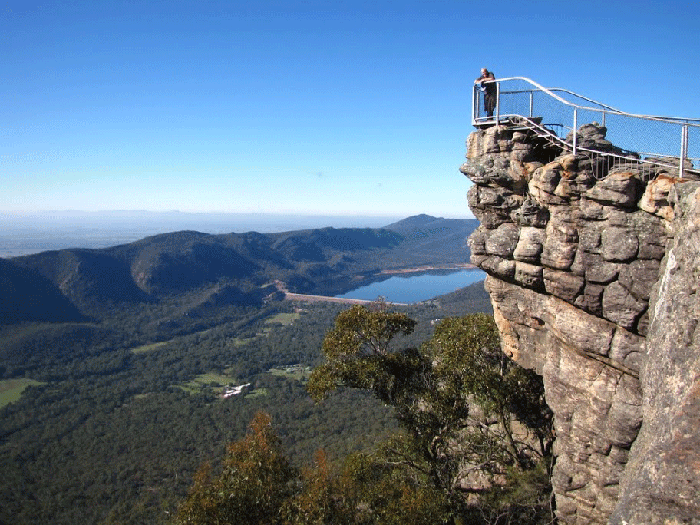
Returning to the caravan later that day, we stopped off at the small supermarket in Halls Gap to replenish a
few supplies. Talk about highway robbery. The prices were higher than those we had encountered in the most remote township we have visited to date,
Borroloola NT. A bottle of tonic water cost 3 times as much as in Melbourne but a girl needs her G&T to get through this tough lifestyle so
we paid the price and vowed to stock up on a few bottles at the next decent size town we encounter.
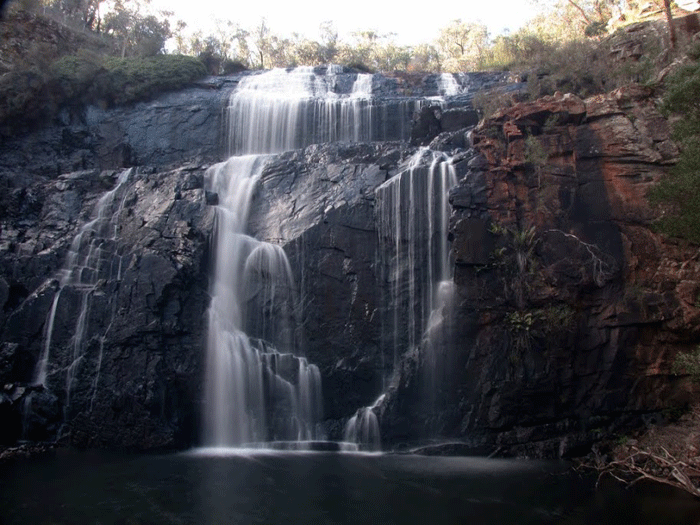
In the morning we awoke to many aching muscles and were predicably not aghast to discover overcast skies and
rain clouds on the horizon. However the threat of rain alone can’t keep us down and we did still manage to climb up the mere 1.4km to the
Beehive falls but the constant drizzling did dampen our enthusiasm to continue on to the top of Mt Dangerous…drats, our disappointment
was palpable. And if you believe that, you probably still believe in the Tooth Fairy too. A picnic lunch at the old Zumstein’s Picnic area
fortified us before heading to the Boroka Lookout which I’m told offers some of the most spectacular views though we could barely see
through the rain clouds that had descending into the valley below.

The following day we drove to Horsham where I managed to post off my latest creations of knit ware to Charlie.
We decided to overnight here en-route to the Little Desert National Park. Horsham, we discovered, is a delightful, thriving outback metropolis.
It hosts a charming regional art gallery and some very good shops and restaurants. The Botanical Gardens are charming, all the locals we encountered
were tremendously friendly and the real estate out here is terrifically affordable almost on par with Sydney……. 25 years ago that is.
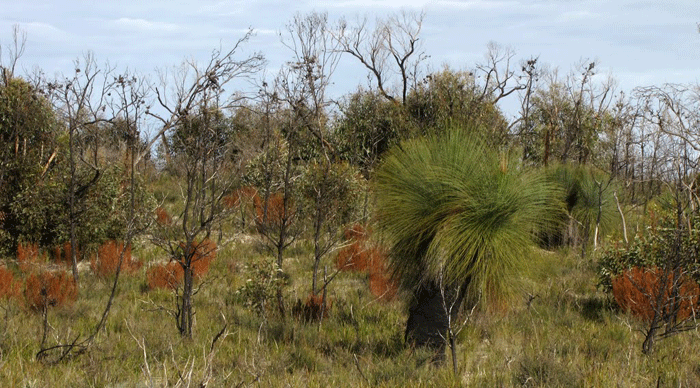
After ascending Mt Arapiles we arrived in The Little Desert National Park. With the information sheet produced by
Victoria’s Parks and Wildlife we were encouraged to explore the park and enjoyed a day driving along the sandy tracks of the Eastern Region
to the Salt Lake. Australia has more than its fair share of salt lakes and this was definitely not the largest nor most impressive that we’ve
seen to date. The allure of the possible sighting of a rare Mallee Fowl enticed us into the Sanctuary Reserve. We did discover its impressive
sandy nest mound but unfortunately nobody was home and we left unrewarded for our effort.
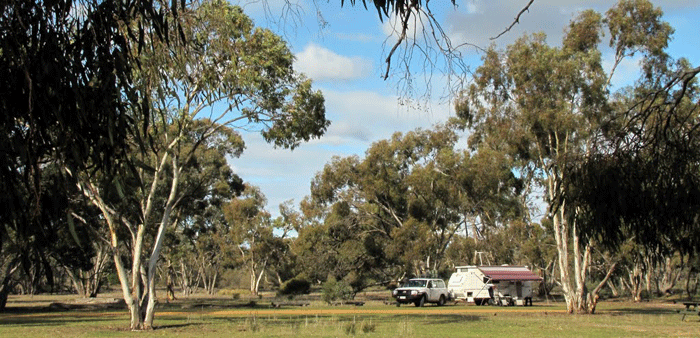
When we awoke the following morning it was real brass-monkey weather and the temperature inside our caravan
was colder than the inside of our refrigerator. We decided two nights camping in the park was probably about as much as we could endure and we
high tailed it to Dimboola, a small country town made famous by the 1969 Jack Hibberd play by the same name. Little has changed in Dimboola since the play was written; it still boasts some quaint historical buildings and an air of having seen better days. The play is still the most viewed in Australia and is produced here a few times a year.

Adjacent the Little Desert National Park is the Wail State Forest on the opposite banks of the Wimmera River.
It has only been six months since the river was little more than a dry dusty trough. After years of drought sufficient rains finally fell last
September to enable the river to flow again and the annual rowing regatta to recommence after a five hiatus.

We traversed the peaks and troughs of the sandy roller coaster ride that is the Wimmera Track through the State
Forest. Almost seasick from the experience we finally stumbled across the Ski-park where we picnicked on the banks of the river before returned
to the caravan for a restorative hot cup of coffee.
All things being equal, tomorrow we will depart Dimboola heading north and plan to free camp in the Big Desert
National Park for a few days while we await a very special delivery in Hopetoun, our monthly coffee supply from Nespresso…. Life is too
short to drink bad coffee.
Changing winds and shifting sands
3 July 2010
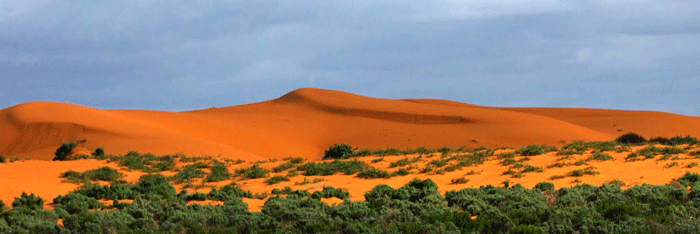
Man thinks he is the architect of his own destiny but, more often than not, a higher authority is pulling the
strings. Sometimes the reasons for the changes in ones fortunes are man-made, others by nature, sometimes it is by bureaucrats or worse still
a committee thereof, but in Australia they are also likely to be because of an introduced species.
In the Australian vernacular “Back of Bourke” implies a very remote location. In the past four
weeks we have been to the back of Bourke and beyond.

Six months ago, on Christmas Eve 2009, the town of Bourke was in the midst of one of its longest and most
sever drought in years. The flat lands around Bourke had been in the grip of drought for almost 10 years. They were on the verge of evacuating
the town as the sadly depleted water supply had all but dried up.
The next day, Christmas Day 2009 up to 100mm of rain fell as an Ex-tropical Cyclone tore across bringing the
heaviest rain falls in a decade to centres including Nyngan, Coonamble and Bourke.

The big wet has brought good fortune to many in the outback. Apart from the obvious benefit to the farmers,
almost every country town is booming from the influx of domestic tourism. The rains have encouraged many people to visit the outback to see the
Darling River flowing again. The region has experienced an increase of over 30% in tourism.
Visitors are flocking to see South Australia's Lake Eyre full of water and combining their voyage with trips up
the Darling to NSW towns such as Lightning Ridge, Broken Hill and White Cliffs, and with visits to national parks such as Paroo-Darling,
Gundabooka, Mutawintji, Kinchega and Mungo.

Gundabooka National Park
I made a poor judgement when I decided we would spend the night in Gundabooka National Park just 40km south
of Bourke. We had spent the day enjoying the marvellous vistas of the red cliffs and gorges and thought we would camp in the park for the night.
Of course when I made the decision I was unaware that it was to be the coldest June day in over 100 years and after we departed the campfire for
the confines of our caravan, spent the rest of the night shivering. Although we had climbed into our beds fully clothed we could not keep warm.
Being a National Park, we were forbidden from firing up the generator to power our heater and awoke to discover the temperature outside had
plummeted to minus 4.1 degrees C and was minus 0.4 inside.

One of Wilcannia remaining Architectural gems
As the crow flies, less than 300km south-west Bourke lays Wilcannia; a town that has seen an enormous shift in
fortunes, it has benefited little from the boom in tourism, many drive through without stopping. Wilcannia had a rich and vibrant history.
Once known as the "Queen City of the West", it was the third largest shipping port in Australia boasting a population of over 3000
and 13 pubs in its hay day.
During the boom years of the 1880's sandstone was quarried locally for the beautiful buildings many of which
still stand today albeit in varies states of disrepair. Just over 120 years since those heady days, virtually the only people left in this
dilapidated town are the remnants of the original inhabitants.

The traditional Aboriginal population, the Barkindji people have been calling vast areas in and around
Wilcannia home for some 40,000 years. They had lived in sync with nature preserving their environment and resources. Their world was turn
upside down with the arrival of the white man. A large percentage died from illnesses that arrived with the white man; illnesses to which
they had little or no immunity. Many that did survive the illnesses suffered annihilation at the hands of the settlers. The remnants of
the once great tribe were placed in Missions where they were taught white-man ways. Those still living in the area today have lost their
traditional way of life and been left to fend for themselves in this now derelict backwater.

Our arrival in Kinchega National Park coincided with the winter solstice. The waters were still flowing
into the Menindee lake system, which is now 85% full after a decade of laying empty after little or no rain; though much to the chagrin of
the residence downstream little has been released into the river system.
Kinchega-Kars pastoral lease covered 800,000 hectares and extended all the way from Menindee to Broken Hill.
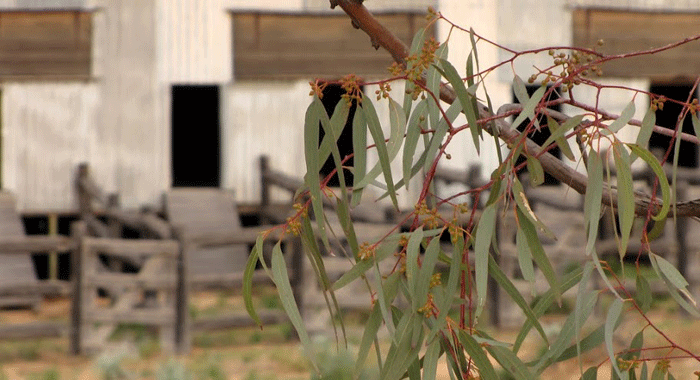
In 1861 Robert Gow headed north-west from Menindee in search of new grazing country. Parts of the west
Darling plains and ranges that Gow explored later became Kinchega station. He crossed wide expanses of saltbush, herbs and grass. This ‘
wilderness’, predicted Gow, ‘will become a land flowing with milk and honey … this enormous tract of country
I have been examining… is fit for occupation and is well supplied with pasture. Horses, cattle and sheep will roll in fat if they
can get water’.
At the time, he was probably unaware that two years earlier, across the border in Victoria, the pompous
fool, estate owner Thomas Austin, wanting a bit of sport, released Twenty-four European Rabbits onto the unsuspecting native flora and
fauna.

Kinchega Station
For years, a flourishing wool industry bloomed at Kinchega. They built a substantial shearing shed, “
built to last a life time”, however between 1894 and 1899 the number of sheep shorn in the district plummeted from 136 000 to 31 000.
It had taken just 45 years for those 24 rabbits to bread like….well, like rabbits and infested the station eating them out of feed in
what were already lean years. The majority of the sheep starved to death.
The Kinchega Station has closed and a large portion was handed over to the NSW National Parks in 1967 and
although it has been over 33 years since the last clip the woolshed, which has stood the test of time, still emits the unmistakable scent of
lanolin.
Australia has the dubious reputation of having sent 23 bird, 4 frog, and 27 mammal species into oblivion
since European settlement of Australia. It is worth making special mention of the three great human-introduced killer species in Australia:
the European rabbit, the European Red Fox, and the domestic cat. Although many other introduced species have played a destructive role, so
far these three have been far and away the most significant.
South of Menindee on the dirt road from Pooncarie we had a yarn with a station manager who we met while we
were parked on the side of the road to have an espresso. He has seen the station weather years of drought. Surprisingly we learnt that another
introduced species, the feral goat, was the only thing that kept the station afloat during the tough years. Brought into the country with the
first settlers they are now estimated to number over 3 million mostly in the semi-arid west. This station of over 58,000 hectares musters over
1,000 goats a month, and ships them off shore, predominantly for the overseas meat market.
More recently another introduced species has wreaked havoc in Australia. The Welsh, red-crested, pinch-faced,
back stabber introduced in the mid 1960’s. It has turned out to be like a cuckoo in the nest of the Australian Labor Party and has caused
the demise of the former Prime Minister K.Rudd. Luckily the only specimen in the wild is a non-breeding female so should be easier to contain
than the dreaded cane toad.
Vote for ME!
13 August 2010
We were back in Brisbane just a week when the Welsh, Red-Crested, pinch-faced, Back-stabber
(Prime Minister Julia Gillard) called a Federal election. It gave us just enough time to update our electoral details but not enough time
to form a new political party. I had planned to contest the next election under the banner of the “Grey Nomad Party”.
This will be the first election where the average age of the politicians is lower than my age. I felt the need to stand if only to increase
the average.

With so many Grey Nomads roaming around Oz it’s about time we had some decent representation.
I plan to conquer the GFC, unemployment, the housing crisis, and Global Warming, to name just a few of the
pressing issues.
With a rapidly aging population I’m sure of winning some votes with my initiatives. Not all are original
but perhaps it will be first time anyone had been so politically incorrect as to actually admit to them out loud.
As neither of the major political parties have actually come out and said what they stand for I thought I’d
beat them to the post. So here are a few my intended policies:
Everyone over the age of 55 who is still working and owns their home outright, will be given a $200,000 credit
(offer limited to one per household). Bugger giving everyman and his dog $900 to send straight to China or Taiwan in return for a shonky wide
screen TV, or handing out bucks to insulate homes and electrocute young apprentices.
The credits will only be doled out if the recipients agree to quit work and either sell their home or rent
it out for at least two years. They must then spend the credits on an Australia made caravan or campervan or mobile home and a fuel-efficient
car or 4x4, one that runs on gas or used cooking oil. Having travelled to some very remote towns in the outback I have discovered that each
and every one has at least one greasy spoon truck-stop diner, one fish and chip shop and one Chinese restaurant. So there is a guaranteed
supply of used cooking oil.
This single initiative will cure most of Australia’s ills. It will free up jobs held by old farts
that have not kept pace with technology, for the younger generation to jump straight into, as they already know everything. It will put
thousands of homes into the rental market overnight. It will also bring employment to the outback, not only in the tourism industry, but in
the shops and allied services too.
Then every citizen will be given 10 free public transport vouchers per week. All buses will be replaced with
natural gas busses such as those made in Brisbane. Overnight the pollution and traffic congestion in our major cities will evaporate while
thousands of jobs will appear for bus drivers and engineers and technicians who design and build these buses. Parking police may need to retrain
as bus drivers, but hey; that’s a small sacrifice to make.
I’d bring back nurses aids and offer a non-university based nursing course for all those who are missing
out on their true vocation simply because they are not cut out for university. I’d make the patients the priority in health care.
On a similar vein, I will make psychometric analysis compulsory for all students in their last year of primary
school and then, using the results, steer the students into an academic or trade based senior school according to their ability. It’s a
waste of everyone’s time and resources trying to push round pegs into square holes. In the real world not everyone is a genius; no matter
what their mother thinks. Having kids struggle to achieve a university degree simply to appease their parents’ ego, when they are not
academically inclined, is not helping their self-esteem especially, when they fail. It is also a waste of taxpayers’ money when they
ultimately drop out. Some kids will not benefit from staying in school beyond year ten when all they really want is to learn a trade. I will
bring back technical high schools and increase apprenticeship funding to offset to costs and encourage more businesses to take on a budding
tradesman.
Every classroom in every school will teach values, the basic values that the majority of Australians believe
in; nothing controversial, just the basics; good manners, honesty, integrity, respect, trust, work ethics...etc. If these values offend anyone,
perhaps they don’t belong here.
I will cancel all university courses that didn’t provide the graduates with a potential to become income
earners. No more “I have a PhD in African Bongo Drumming…. Do you want fries with that?” Currently universities are being used
as expensive childcare facilities for over indulged teenagers who don’t know what they want to be when they grow up. Let them grow up first.
If they don’t know what they want to be by the time they leave high school, then a couple of years of national service might give them time
to think about it while contributing to society instead of botting off it.
For truly gifted children, scholarships will be awarded for all levels of education. Also, to encourage them to
reproduce they will be entitled to heavily subsidised childcare when they marry. The more educated a person is, the fewer children they produce,
and sadly the inverse is also true.
If the politician were not trying to be so politically correct they will have noticed the “dumbing down”
effect of our social security system years ago. Under my government, the cradle-to-grave social security recipients will not benefit by breeding
like flies. More than two kids will result in a reduction in their handout not an increase. The rest of us limit our family size to match our
financial ability to support them, the only people who have more than 3 or 4 kids these days are the ones living off taxpayers. Couples working
for a living should be the ones encouraged to have more children. I will give them free childcare and paid maternity/parental leave for 6 months.
All incomes under $30K will be tax free, over that, there will be a flat rate of tax for everyone, rich and poor.
Single income families will be allowed to split the income between the two partners and for every child they have, there will be a substantial tax
deduction.
No able-bodied person under 21 will be eligible for unemployment benefits. Parents will be made responsible for
the kids until they reach their majority. Then, if they still can’t find a job after their 21st birthday there will always be the option of
conscription. Both military and civil service will be offered to anyone unable to find a paying job. If you don’t want to enlist, you
can always learn to drive a bus.
The single-parent benefit will be scrapped. You breed them; you feed them. The government will provide free
childcare for all single parents so they can get jobs like the rest of us working mothers have done for years. We coped, so can you! With the
above-mentioned initiatives, there will be plenty of jobs to apply for. Try learning to drive a bus.
This country has too many bureaucrats so I will reduce the levels of government from local, state and federal
to just local and federal only. I’d cut out all the states and have just the one country, Australia; after all, we only have a mere 25 million
citizens. This initiative will make the national curriculum and a national health care system a foregone conclusion with just one foul swoop of
the red biro. That will also free up at least three Wednesday nights in winter for improved television viewing, as the “State of Origin” football series will become obsolete. There are, after all, only so many times I can bear watching a bunch of gorillas chasing a bundle of pigskin around a field whilst using it as an excuse to pound each other to a pulp, for an obscene amount of money.
We are such a complacent nation that the government had to make voting compulsory for fear we will all head to
the beach in preference to the polling booth on election Saturday.
We Australian’s are so excited by this election that last week’s ‘Great Debate’ between
the Prime Minister and the leader of the opposition had to be rescheduled. It clashed with the final episode of ‘Master Chef’, a cooking
show where contestant can be voted off the island for flambéing when they should have sauteed. They feared no one will tune into the debate
so they brought it forward. Of course those who did watch it were bored to tears anyway, as it was less stimulating that watching the paint dry.
The only thing people can remember of the whole event was that the Prime Minister has big ear lobes and the leader of the opposition has wing nut
ears.
With only three weeks to go before the election, the campaigns have hit fever pitch. We are now being subject to
hours of tedious political commercials each night, as the major contenders spend our hard earned taxpayer dollars to berate their opponents,
over all manner of media, without actually enlightening us to their own policies.
So if you’ve lost your appetite for the major political parties, vote “one” for the Grey
Nomad Party, I need a better retirement package; I’m sure $600K per year offered to all retiring Australian Prime Ministers should just
about pay for a lifestyle to which I could become accustomed.

A Vegetative State
14 September 2010
It's all over bar the shouting.
While the votes were counted and recounted and our country’s leaders courted the independents.
For a pound of flesh, they would pledge allegiance to the minority government giving them the necessary seats to govern our fair nation.
We feared we might end up, like the national parliament, in a vegetative state.
It couldn’t have been further from the truth. We had no idea our life would be so full-on.
Since returning to Brisbane we have bought a house, then spent three weeks painting it internally and recarpeted the whole place in
preparation for tenants to move in. After all the hard work was over we thought we would finally have time to do some serious vegging out.
However we hadn’t taken into account our hectic social calendar. It has kept us very busy. Vegging out would apparently have to wait
for another time.
During our sojourn in Brisvegas we have been invited to all manner of celebrations. From the 50th wedding
anniversary of our dear friends and community stalwarts, Frank and Evelyn to the 40th birthday party of my buddy, the eternally youthful,
Ann-Maree to my talented nephew, Joshua’s 21st; Not to mention the numerous dinner invitations. Thank you everyone for making our time
here so memorable.
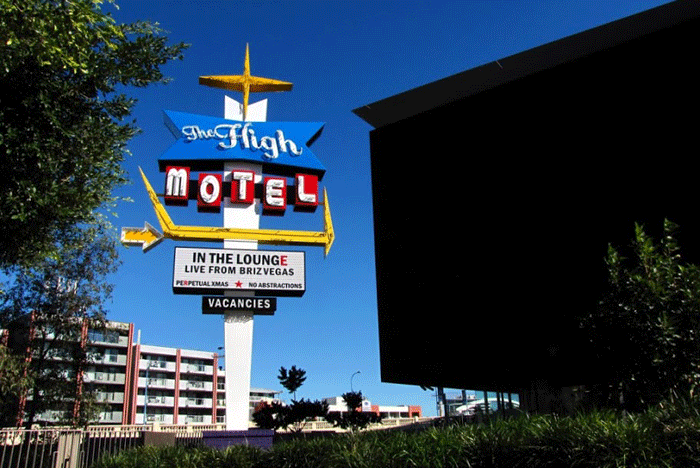
As luck would have it, we arrived in Brisbane at the best time of year, the dry season, otherwise known as winter.
But with the average daily maximum temperature of 24 degrees C it’s more like an English Summer. The day spring arrived it was 28
degrees with clear sunny skies. It is typical of Brisbane weather to skip spring altogether. One day winter; next day summer.
Of course the best thing about spring in Brisbane is the Brisbane Festival and my favourite event of the
Brisbane Festival; Riverfire. The city comes alive with fireworks and this year was the final fly-by of the F111’s with their trademark “
Dump and Burn” where they dump fuel and ignite it with their afterburners. Unfortunately they are to be put out to pasture. Their replacements
are not equipped to provide the same entertainment value. Not that I am suggesting that the sole value of a fighter jet is to provide free
entertainment to the citizens of Brisbane, but it helps.

My sister, bless her little cotton socks, provided us with the perfect vantage point from which to view this
spectacular, she kindly bought a unit overlooking the Storey Bridge. What a gal, and to think she did that just for us….. and I still
believe in the tooth fairy.

This is our last week in Brisbane. We have spent the last three house-sitting for a lovely couple, Dianne and
Robbie. The house comes with the added benefit of a serious hot tub in the courtyard. Talk about great perks. This is going to be a hard act to
follow.
Although we have been in Brisbane for over two months we still have not managed to see all the people we
intended to see. If you missed out, I’m sorry and promise to make it up to you next time we hit Brisvegas, all things being equal, in about
six months time.
All good things must come to an end, eventually, and so it is with our nomadic lifestyle. When we return in
April next year we intend to sell the caravan and after almost three years on the road, settle down for a while. Of course our definition of “
settling down” may not necessarily preclude jetting off every now and then. I don’t expect to be cured of my itchy-feet syndrome
any time soon.
In the mean time, next week we depart Brisbane and start meandering down south towards Melbourne. We hope
to get some quality “Charlie time” in before we fly out on 4 November to spend 2 months discovering the delights of Vietnam,
Cambodia, Laos and Thailand. Charlie is currently travelling in the UK. One grandma’s loss is another grandma’s gain.
He should be back in Melbourne before we arrive. Only four months old and an international jet setter already; he really is a chip
off the old block.
Never work with children or satellite navigation systems.
22 September 2010
After having spent over two months hibernating in Briz Vegas we hit the road again and started
our journey back south towards our rendezvous with our grandson Charlie. Our route took through Mt Linday heading towards Tenterfield with a
slight detour off the beaten track, through Urbenville, where we found everyone was dressed in period costume. We thought we had arrived
back 100 years in time; until we saw the sign for the centenary of the local public school.
Not far from Urbenville are the Tooloom Falls where we set up camp for our first night back on the road.
An aboriginal chap going by the name of Rob Williams chatted with us while a younger man scammed $50 out of some younger campers telling
them there was a charge for camping on Aboriginal land…Free campers beware!

Although it is only about 30 km, as the crow flies from where our farm was in Maryvale, it was separated from us by a mountain range and,
is often the case when you are eking out a living on the land, time for recreation was always at a premium. But now we had all the
time in the world & were rewarded with this delightful scenery.

Tooloom Falls
I was hell bent on keeping a promise that if I was ever in Tenterfield I’d call in and see my old work colleague, Heidi. Of course I
should have thought about this before leaving Brisbane where we had internet on tap. By the time we reached Tenterfield I realised that no only
I didn’t have her phone number, I had also forgotten the surname of her fiancé. So how do you find someone in a country town when
the internet is pretty miserable at your campsite? Well you ask the local check-out chicks in the only supermarket in town. If I only
learnt one thing from our years in a small country town it is that everyone knows your business. So armed with Heidi’s name,
her fiancé’s first name and the fact they were planning to marry in the near future it didn’t take long to get their
entire family history and a phone number.

With Heidi (on right)
It was lovely to see Heidi again and meet her charming fiancé, Tom up at their property outside of town. We found our way there
carefully following Heidi’s detailed instructions, but leaving was another matter. As has happened in the past, our GPS was hell
bent on leading us up the garden path.
Once before, when we were farm sitting at Merrijig, near Mansfield and wished to visit the markets in Jamieson, our GPS decided that the
best way was to cut through a farmer’s paddock. Alarm bells should have rung when, part way along the dirt road, we encountered a gate.
But being a Capricorn I am nothing if not stubborn.
“I’ll be fine”, I reassured poor hubby, “there’s bound be another gate at the other end and we can join the main road
there.”
ell sure enough after about an hour of traversing all the winding tracks through the farm we found the gate at the main road…Locked!
So around we turned and retraced our journey back to the first gate and made our way to Jamieson via the bitumen like everyone else.
This time as soon as we saw the gate we did a three point turn, which was really more like a 53 point turn as we were towing our caravan
and the road was only 3m wide. We retraced our path until we eventually found an alternate route that didn’t include trespassing. Bloody GPS!
We then sojourned in Melbourne for a couple of months, enjoying time
with our first grandchild, before returning to Brisbane in March
2011 to start our life over as home renovators for the next year.
|